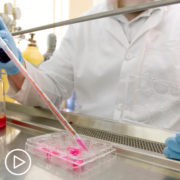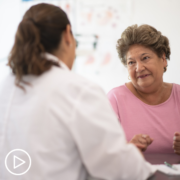Clinical Trials for Myeloma Treatment | Essential Information for Patients
Clinical Trials for Myeloma Treatment | Essential Information for Patients from Patient Empowerment Network on Vimeo.
How do clinical trials advance treatment options for myeloma? Dr. Omar Nadeem discusses the important role of clinical trials in improving patient care, key questions to ask your care team about trial participation, and the benefits of seeing a myeloma specialist.
Dr. Omar Nadeem is the Clinical Director of the Myeloma Immune Effector Cell Therapy Program and Associate Director of the Multiple Myeloma Clinical Research Program at the Dana-Farber Cancer Institute. Learn more about Dr. Nadeem.
Related Resources:

|

Personalized Medicine for Myeloma Treatment | What Patients Should Know |

|
Transcript:
Katherine:
I’d like to start with the importance of a patient’s healthcare team. What are the benefits to seeking care with a myeloma specialist, even if it’s just for a second opinion or a consult?
Dr. Nadeem:
Yeah, so, myeloma is a little less than 2 percent of all cancers, and it’s the second most common blood cancer, so certainly not rare. With that being said, if you go to a general community practice, they don’t typically see too, too many patients with this disease. So, alongside that, we have so many different treatment options and combinations and these, as I mentioned, immune therapies.
And other therapies that are only actually carried out at academic centers for now, such as stem cell transplants, and CAR T-cell therapy.
I think it’s important to kind of meet with an academic provider just to get a sense of what the patient may be facing, both in that immediate time, but also in the future, because a lot of myeloma therapy is lifelong. And in that case, you do have to come up with a plan for your whole treatment in a way early. So, it’s important to kind of one: hear it from another person, and then two: really sort of figure out what the outlook would look like for the individual patient.
With that being said, many of our myeloma regimens that are approved can very easily be given at the local provider, and that’s usually our preference, for patients to be treated closer to home. So, ultimately, this is another way for patients to get input about their treatment program, but also talk about the future.
Katherine:
That makes sense. Specialists at academic medical centers are typically more involved in research and clinical trials.
And patient participation is essential to advancing medicine. So, how do clinical trials impact myeloma care?
Dr. Nadeem:
Well, everything that we have available today for myeloma therapy was once in a clinical trial. So, all these promising therapies usually start in early phase studies and move on to Phase II and Phase III studies, and then those are the ones that the FDA uses to approve a particular combination.
So, it all depends on kind of where someone is in their disease course. It also kind of depends on what their preferences may be in terms of taking on something that is beyond standard of care. So, as part of any clinical trial in whatever phase it may be, whether its newly diagnosed multiple myeloma, even smoldering myeloma, which is one step before that, relapsed/refractory myeloma…
At each step of the way, there are clinical trials that are there trying to improve upon what’s already out here, right? So, we are, despite all these amazing advances, unfortunately, the disease is still not curable for a vast majority of patients.
In that case, how do we move to that cure, or how do we kind of advance the disease even beyond this? And a clinical trial is a way to do that.
Katherine:
What type of patient is most appropriate for a clinical trial?
Dr. Nadeem:
So, there are criteria that each clinical trial uses in terms of eligibility. Some of that has to do with the disease characteristic itself, kind of where somebody is in their disease course, but many times it’s also patients’ fitness, organ status in terms of kidney function, their blood count to some extent, heart function, etcetera. There are some sort of minimal prerequisite guidelines that we have to enroll patients in trials. So, it really, again, depends on where somebody is in their disease course and what they may be willing to take on beyond what may be offered to them as part of standard of care.
Katherine:
What questions should patients be asking if they’re entrusted in participating in a clinical trial?
Dr. Nadeem:
I think the important thing is to sort of first recognize what’s available to them as part of standard of care and then what the clinical trial is trying to answer.
So, for example, if it’s newly diagnosed multiple myeloma, we now have quadruplet regimens that we give to patients at the time of their diagnosis, and then the next natural question for eligible patients that now comes up is whether they should do a stem cell transplant or not.
And alongside that goes with all these advances in immune therapies, such as CAR T-cell therapies and bispecific antibodies. And there are now trials looking at those therapies and comparing them, for example, to stem cell transplant to try to answer the question “Can we get even beyond something like a stem cell transplant?”
So, that’s one example of a trial where a patient may be interested in saying “Okay, well, a transplant may be my standard path, but what if I try to enroll in this study and get randomized, for example, to the CAR-T arm? Then, perhaps, I’m getting access to some of these therapies early and maybe that’s going to improve my outcomes.”











